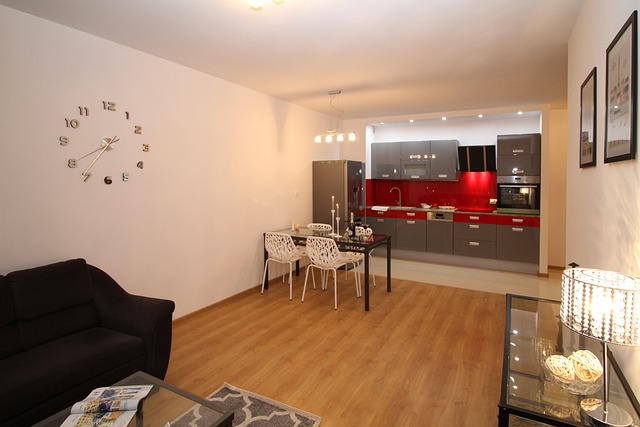An organized kitchen layout optimizes storage for cookware, condiments, and appliances, enhancing functionality and aesthetics. It involves strategic cabinet placement, open storage, wall-mounted racks, under-counter shelves, and multifunctional appliances. Drawer organizers, transparent containers, and vertical shelf spaces maximize storage efficiency, keeping items accessible while reducing clutter. This layout streamlines meal prep, improves safety, and fosters a welcoming culinary environment.
In today’s world, a well-organized kitchen is not just about aesthetics; it’s a functional space that caters to our daily needs. With an array of appliances, cookware, and snacks to store, efficient organization is key to a smooth culinary experience. This article explores various strategies to maximize storage in your kitchen, from assessing your needs to leveraging every inch of wall and vertical space. Discover how to create a seamless, organized kitchen layout that simplifies your routine.
Understanding Storage Needs: A Kitchen Assessment
In designing or reorganizing your kitchen, understanding your storage needs is paramount. A well-organized kitchen layout should cater to various types of items, from cookware and utensils to snacks, condiments, and appliances. Start by assessing your current collection of culinary tools and pantry staples. Identify frequently used items that require easy access and those that are less often needed but still essential. This process will help you decide on storage solutions like pull-out drawers for pots and pans, adjustable shelves for canned goods and snacks, or dedicated spaces for appliances.
Consider the workflow in your kitchen as well. Items used together should be grouped together to optimize space and efficiency. For example, placing spices and cooking oils within arm’s reach of the stovetop or grouping snacks and condiments near the dining area or island. By tailoring storage options to your specific needs and using intelligent organization techniques, you’ll create a functional and inviting kitchen layout that supports your daily culinary endeavors.
Optimizing Wall Space for Cabinets and Shelves
In an organized kitchen layout, optimizing wall space is key to achieving ample storage for all your culinary needs. One effective strategy is to install cabinets and shelves that maximize the vertical dimensions of your walls. Lower cabinets with pull-out drawers can provide easy access to frequently used items like cookware and snacks, while taller upper cabinets offer dedicated spaces for less frequently accessed appliances and seasonal decorations.
Consider incorporating floating shelves or open storage solutions above countertops or islands to display decorative items while keeping them within reach. This not only adds visual interest but also ensures that your kitchen remains both functional and aesthetically pleasing. By thoughtfully planning and utilizing wall space, you can create a streamlined and organized kitchen layout that caters to all your culinary storage requirements.
Incorporating Smart Storage Solutions for Appliances
In a well-organized kitchen layout, incorporating smart storage solutions for appliances plays a pivotal role in maximizing space efficiency. This includes utilizing vertical real estate with wall-mounted racks and under-counter shelves, which not only declutters your workspace but also makes it easier to locate and access frequently used items. Moreover, consider investing in multifunctional appliances that can serve multiple purposes, reducing the number of individual gadgets crowding your cabinets.
Smart storage doesn’t stop at physical organization; it extends to technological advancements. Smart appliances connected via IoT (Internet of Things) allow you to manage and monitor your kitchen equipment remotely. From preheating ovens to ensuring food is stored at optimal temperatures, these devices contribute to a streamlined cooking experience while keeping your kitchen layout organized and clutter-free.
Maximizing Drawer Organization for Utensils and Snacks
In an organized kitchen layout, maximizing drawer space for utensils and snacks is a game-changer. Start by sorting items into categories—knives and cutting boards, measuring cups and spoons, baking tools, and snack packs. Use dividers to create compartments within each drawer, ensuring everything has its place. This not only keeps your drawers neat but also makes it easier to find what you need quickly.
Consider using small, transparent containers for snacks to see what’s inside without having to dig through them. Label these containers with the contents to further enhance organization. For utensils, invest in slim, stackable organizers that fit perfectly into drawers, ensuring your tools remain untangled and easy to access during meal preparation.
Utilizing Vertical Space with Over-the-Stove and Under-sink Storage
In an organized kitchen layout, maximizing vertical space is key for efficient storage. Over-the-stove and under-sink areas often go unnoticed but offer significant potential. Install sleek, custom shelves above the stove to store spices, cooking oils, or even decorative items that add to your kitchen’s aesthetic. This not only keeps these essentials within reach but also contributes to a clutter-free environment. Similarly, under-sink storage solutions can accommodate various tools and appliances, from extra pots and pans to cleaning supplies. Pull-out drawers or slim, tailored cabinets maximize the available space, ensuring everything is easily accessible yet neatly tucked away.
By utilizing these vertical real estate spots, you can achieve a more organized kitchen layout without sacrificing precious counter space. This clever approach allows for better airflow around the stove and sink areas, making your cooking experience safer and more enjoyable. Plus, with well-planned over-the-stove and under-sink storage, you’ll find yourself wasting less time searching for items and more time enjoying mealtimes with friends and family.
A well-organized kitchen layout not only enhances the aesthetic appeal but also improves functionality. By understanding your storage needs through a comprehensive kitchen assessment, optimizing wall space with cabinets and shelves, incorporating smart solutions for appliances, maximizing drawer organization, and utilizing vertical spaces, you can create a streamlined and efficient cooking environment. These strategies ensure that everything has its place, making meal preparation and cleanup a breeze while also providing ample space for all your cookware, snacks, and essential appliances.
